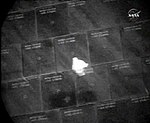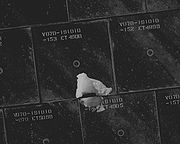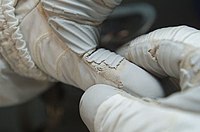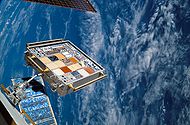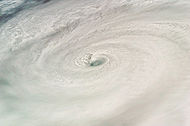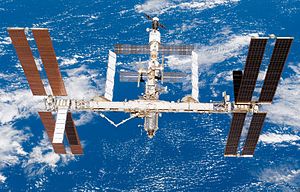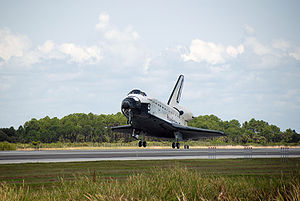STS-118/Timelines: Difference between revisions
Pat Palmer (talk | contribs) m (Text replacement - "Idaho (U.S. State)" to "Idaho (U.S. state)") |
Pat Palmer (talk | contribs) |
||
| (One intermediate revision by the same user not shown) | |||
| Line 71: | Line 71: | ||
==Tuesday 14 August (Flight day 7)== | ==Tuesday 14 August (Flight day 7)== | ||
[[Image:STS118 ESP on RMS.png|thumbnail|right|230px|Backdropped by Earth, ''Endeavour'''s [[Canadarm]] moves the external stowage platform (ESP-3).]] | [[Image:STS118 ESP on RMS.png|thumbnail|right|230px|Backdropped by Earth, ''Endeavour'''s [[Canadarm]] moves the external stowage platform (ESP-3).]] | ||
The ''Endeavour'' crew awoke on Tuesday to the voices of Tracy Caldwell's family singing happy birthday to her. The two crews successfully removed the [[External Stowage Platform|ESP-3]] from ''Endeavour'''s payload bay, and installed it onto the [[Integrated Truss Structure#P3.2FP4.2C S3.2FS4 truss assemblies|P3]] truss. They also continued with transfer activities, and several crew members took time out to have two Public Affairs events, one of them answering children's questions from the Discovery Center in [[Boise]], [[Idaho (U.S. state)]]. <ref>{{cite news | first= | last=NASA | coauthors= | title=STS-118 Status Report #13 | date=2007-08-14 | publisher=NASA | url =http://www.nasa.gov/mission_pages/shuttle/shuttlemissions/sts118/news/STS-118-13.html | work = | pages = | accessdate = 2007-08-15 | language = }}</ref> During an interview with CBS, Commander Kelly stated that he was not concerned about the tile damage, and would be comfortable with any decision NASA made, "My understanding is this tile damage is not an issue of the safety of the crew... I'm not concerned with our safety." <ref>{{cite news | first=William | last=Harwood | coauthors= | title=Kelly downplays tile concern; Morgan said spaceflight worth the wait | date=2007-08-14 | publisher=CBS News | url =http://www.cbsnews.com/network/news/space/current.html | work = | pages = | accessdate = 2007-08-14 | language = }}</ref> The main reason for fixing it, he noted, would be to assist with processing once the orbiter was back at the Kennedy Space Center. | The ''Endeavour'' crew awoke on Tuesday to the voices of Tracy Caldwell's family singing happy birthday to her. The two crews successfully removed the [[External Stowage Platform|ESP-3]] from ''Endeavour'''s payload bay, and installed it onto the [[Integrated Truss Structure#P3.2FP4.2C S3.2FS4 truss assemblies|P3]] truss. They also continued with transfer activities, and several crew members took time out to have two Public Affairs events, one of them answering children's questions from the Discovery Center in [[Boise, Idaho|Boise]], [[Idaho (U.S. state)]]. <ref>{{cite news | first= | last=NASA | coauthors= | title=STS-118 Status Report #13 | date=2007-08-14 | publisher=NASA | url =http://www.nasa.gov/mission_pages/shuttle/shuttlemissions/sts118/news/STS-118-13.html | work = | pages = | accessdate = 2007-08-15 | language = }}</ref> During an interview with CBS, Commander Kelly stated that he was not concerned about the tile damage, and would be comfortable with any decision NASA made, "My understanding is this tile damage is not an issue of the safety of the crew... I'm not concerned with our safety." <ref>{{cite news | first=William | last=Harwood | coauthors= | title=Kelly downplays tile concern; Morgan said spaceflight worth the wait | date=2007-08-14 | publisher=CBS News | url =http://www.cbsnews.com/network/news/space/current.html | work = | pages = | accessdate = 2007-08-14 | language = }}</ref> The main reason for fixing it, he noted, would be to assist with processing once the orbiter was back at the Kennedy Space Center. | ||
During the Mission Management Team briefing, Kirk Shireman, Deputy International Space Station | During the Mission Management Team briefing, Kirk Shireman, Deputy International Space Station | ||
| Line 93: | Line 93: | ||
The station and shuttle crews continued transfer activities on flight day 9, as well as EVA preparations, which included TPS repair procedure review, in case NASA decided a repair was necessary. <ref>{{cite news | first=Marcia | last=Dunn | coauthors= | title=Astronauts run through repair methods | date=2007-08-17 | publisher=Associated Press | url =http://www.chron.com/disp/story.mpl/ap/tx/5060949.html | work = | pages = | accessdate = 2007-08-17 | language = }}</ref> <ref>{{cite news | first=David | last=Malakoff | coauthors= | title=NASA Nears Decision on Shuttle Repair | date=2007-08-17 | publisher=NPR | url =http://www.npr.org/templates/story/story.php?storyId=12833716 | work = | pages = | accessdate = 2007-08-17 | language = }}</ref> | The station and shuttle crews continued transfer activities on flight day 9, as well as EVA preparations, which included TPS repair procedure review, in case NASA decided a repair was necessary. <ref>{{cite news | first=Marcia | last=Dunn | coauthors= | title=Astronauts run through repair methods | date=2007-08-17 | publisher=Associated Press | url =http://www.chron.com/disp/story.mpl/ap/tx/5060949.html | work = | pages = | accessdate = 2007-08-17 | language = }}</ref> <ref>{{cite news | first=David | last=Malakoff | coauthors= | title=NASA Nears Decision on Shuttle Repair | date=2007-08-17 | publisher=NPR | url =http://www.npr.org/templates/story/story.php?storyId=12833716 | work = | pages = | accessdate = 2007-08-17 | language = }}</ref> | ||
Mission Specialists Barbara Morgan and Alvin Drew participated in an education event in the morning with students at the [[Challenger Center for Space Science Education]] in [[Alexandria]], [[Virginia]]. The event was hosted by Dr. June Scobee Rogers, wife of ''Challenger'''s commander, [[Dick Scobee]], and Founding Chairman of the Challenger Center. Morgan and Drew also spoke to reporters from the Associated Press, Reuters and Idaho Public Television. <ref>{{cite news | first=Liz | last=Austin Peterson | coauthors= | title=NASA Optimistic No Shuttle Fix Needed | date=2007-08-17 | publisher=AP/Discovery News | url =http://dsc.discovery.com/news/2007/08/16/shuttlethursday_spa.html?category=space | work = | pages = | accessdate = 2007-08-17 | language = }}</ref> | Mission Specialists Barbara Morgan and Alvin Drew participated in an education event in the morning with students at the [[Challenger Center for Space Science Education]] in [[Alexandria]], [[Virginia (U.S. state)|Virginia]]. The event was hosted by Dr. June Scobee Rogers, wife of ''Challenger'''s commander, [[Dick Scobee]], and Founding Chairman of the Challenger Center. Morgan and Drew also spoke to reporters from the Associated Press, Reuters and Idaho Public Television. <ref>{{cite news | first=Liz | last=Austin Peterson | coauthors= | title=NASA Optimistic No Shuttle Fix Needed | date=2007-08-17 | publisher=AP/Discovery News | url =http://dsc.discovery.com/news/2007/08/16/shuttlethursday_spa.html?category=space | work = | pages = | accessdate = 2007-08-17 | language = }}</ref> | ||
During the interview with Reuters, Drew stated "We've been talking to the engineers who have been analyzing this far more than we have in space, and they seem to feel that the biggest danger is more to just being able to re-use ''Endeavour'' once it gets back on the ground. They seem to be confident, and I trust their confidence that we can get home safely even with the divot that we have in the belly," <ref>{{cite news | first=Irene | last=Klotz | coauthors= | title=Shuttle crew awaits word on heat shield work | date=2007-08-17 | publisher=Reuters | url =http://www.reuters.com/article/scienceNews/idUSN1635725420070816 | work = | pages = | accessdate = 2007-08-17 | language = }}</ref> Morgan added "We have a lot of faith in the program, and we'll do what the engineers decide is the best thing for us to do. We have all confidence we're going to be able to do the right thing." | During the interview with Reuters, Drew stated "We've been talking to the engineers who have been analyzing this far more than we have in space, and they seem to feel that the biggest danger is more to just being able to re-use ''Endeavour'' once it gets back on the ground. They seem to be confident, and I trust their confidence that we can get home safely even with the divot that we have in the belly," <ref>{{cite news | first=Irene | last=Klotz | coauthors= | title=Shuttle crew awaits word on heat shield work | date=2007-08-17 | publisher=Reuters | url =http://www.reuters.com/article/scienceNews/idUSN1635725420070816 | work = | pages = | accessdate = 2007-08-17 | language = }}</ref> Morgan added "We have a lot of faith in the program, and we'll do what the engineers decide is the best thing for us to do. We have all confidence we're going to be able to do the right thing." | ||
Latest revision as of 08:14, 4 September 2023
Wednesday 8 August (Flight day 1, Launch)
Fueling of the external tank began at 8:11 a.m. EDT (12:11 UTC) and finished around 11:00 a.m. EDT. The Ice Team began their inspection of the orbiter to ensure no ice was on the orbiter or the fuel tank, unlikely due to the unusually warm conditions as launch time approached. Their inspection lasted about 40 minutes shorter than the usual two hours. The crew departed for the Operations & Checkout (O&C) building, for the launch pad at 2:46 p.m. EDT (18:46 UTC), and arrived at the pad at 3:02 p.m. EDT (19:02 UTC). Launch occurred at 6:36:42 p.m. EDT (22:36:42 UTC). All systems were reported to be working well.
Countdown and launch notes:
- The Ice Team members discovered a small crack in the foam surrounding the external fuel tank during their preflight examination. After a review by the Mission Management Team, it was concluded that there was no debris issue regarding the crack, and the tank was safe to fly.
- A problem with the switches associated with the crew hatch required a second and third hatch closure attempt. Hatch closure was completed and verified at 5:23 p.m. EDT (21:23 UTC).
- The high-definition video camera used to inspect the shuttle from Kennedy Space Center during launch failed prior to liftoff. The launch team decided that the cameras on the external tank and the orbiter would be sufficient for observations, and went on to launch without it.
- Launch Director Mike Leinbach conducted his T-9 poll, and declared Endeavour a "go" for launch at 6:26 p.m. EDT (22:26 UTC).
- Liftoff occurred at 6:36:42 p.m. EDT. (22:36:42 UTC)
- Solid Rocket Boosters successfully separated at 6:39 p.m. EDT (22:39 UTC).
- Main Engine Cutoff occurred at 6:45:30 p.m. EDT (22:45:30 UTC)
- External Tank separation occurred at 6:45:45 p.m. EDT (22:45:45 UTC)
The primary TAL site was Zaragoza Airport in Spain.
Following the procedures for post-ascent, the crew opened the payload bay doors, activated the Spacehab, powered up the Remote Manipulator System, and performed a variety of other payload activation procedures, before entering their scheduled sleep shift at 04:36 a.m. UTC (12:36 a.m. EDT) August 9, 2007.
Thursday 9 August (Flight day 2)
The shuttle crew spent most of the day inspecting the outer hull and the heat shield. During the mission status briefing, Deputy Shuttle Program Manager (and Mission Management Team chairman) John Shannon reported that during launch, approximately nine pieces of foam were observed breaking off the external fuel tanks. Three of these struck the shuttle. All three strikes are considered to be minor in nature.[1]
Friday 10 August (Flight day 3)
Endeavour successfully docked with the International Space Station at 18:02 UTC (2:02 p.m. EDT). Approximately an hour before docking, Endeavour performed the one-degree-per-second backflip, called the Rendezvous Pitch Maneuver (RPM), so the ISS crew members could take digital pictures of the heat shield of the orbiter. The images were then analyzed by NASA's Image Analysis Team, as well as the Mission Management Team to help determine the safety of the orbiter's heat shield. Following a series of leak checks, the hatches were opened at 20:04 UTC (4:04 p.m. EDT), and the Expedition 15 crew welcomed the STS-118 crew aboard the station.
After preliminary review of the photos taken by the Expedition 15 crew during the RPM, an area of interest was discovered on the underside of the Shuttle; an area behind the right landing gear door covered with black silica tiles.[2] The tile directly aft of the door had a 3.5 inch (8.9 cm) by 2 inch (5.1 cm) gouge in it. While the tile was penetrated, the underlying felt backing wasn't. NASA noted in the press conference that launch-time video did confirm a foam strike. This area is less critical than the leading-edge reinforced carbon-carbon tiles that were damaged in the Space Shuttle Columbia disaster, but did cause concern for the Mission Management Team. A focused inspection was scheduled for Sunday, August 12 to determine whether a patch attempt would be undertaken by the astronauts during an EVA.[3]
The crew activated the Station-to-Shuttle Power Transfer System (SSPTS) after docking.[4] SSPTS transfers electrical power from the station to the shuttle, allowing the shuttle to conserve its own power generating resources. Extension of the STS-118 from 11 to 14 days was dependent on proper operation of SSPTS.
Saturday 11 August (Flight day 4)

At 21:45 (UTC), Rick Mastracchio and Dave Williams started the first EVA of the mission, installing the S5 truss to the station, increasing the total mass of the ISS to 232,693 kg (513,000 lb). The EVA duration was 6 hours and 17 minutes, and all objectives were successfully completed.
During the Mission Status press conference, Lead ISS Flight Director Joel Montalbano reported that the SSPTS was working well, and the recommendation to the Mission Management Team will be to extend the mission to the planned 14-day mission.
Mission Management Team chair John Shannon reported after additional analysis, it appeared that a piece of foam came off the external tank in the area of the tank's feed line, and bounced off a nearby strut, resulting in a hit to the orbiter's underside. An almost identical section of foam was lost on STS-115, but did not strike the orbiter. John reported after further review of photos taken on flight day three, they do not feel the damage went all the way through the tile, but focused inspection is still planned for flight day five, and decisions would not be made until more information is obtained. Five specific areas will be inspected during focused inspection, and with the data gathered, thermal testing can be done to determine what actions, if any, need to be taken.
Overall, John Shannon classified the foam loss as a "concern", but only with regards to the history that the specific area has with regards to foam loss in past missions. Shannon reported that analysis would be complete by Tuesday at the latest.
John Shannon also reported that the possible protruding gap filler noticed on flight day 3, was reviewed further, and was determined to be "shim stock", which will burn off in the upper atmosphere, and poses no issues for re-entry.
Sunday 12 August (Flight day 5)
The crew carried out the focused inspection without any problems, and at 20:56 (UTC), the crews of Endeavour and Expedition 15 were notified that the SSPTS was working as expected, and the mission was officially extended to the planned 14 day mission. Commander Scott Kelly replied, "That's great news, thanks".[5]
In the daily mission status briefing, Lead Flight Director Matt Abbott announced the official extension of the mission, that the SSPTS was working as planned, and they were pleased with the data gathered during the focused inspection on Sunday. Mission Management Team Chairman John Shannon confirmed the decision of the Mission Management Team to extend the mission to 14 days, and to add a fourth EVA, was unanimous. He noted that the addition of SSPTS will be a valuable new tool, providing not only extended missions, but also the ability to provide the space station with additional supplies of oxygen, water, and other resources.
Shannon reported on the focused inspection, confirming that good laser data and imagery was obtained, and they resolved several areas of interest, classifying them as of no concern. One area of interest was two adjacent thermal plates on the shuttle's underside that had a gouge that appeared to be deeper than would allow them to rule it out. NASA would use data from the focused inspection to model the area, and do thermal analysis of the area.[6] They will use the data to mimic the damage with sample tiles at Johnson Space Center, and using a variety of testing methods, possible courses of action would then be evaluated. No decision would be made until all data had been received and reviewed.
Shannon did report that following STS-118, NASA will do a thorough review of the history of foam loss from the area of the external tank since STS-114, analysis and testing would be done, and any speculation as to a future course of action would not be made until all the information was available.
Monday 13 August (Flight day 6)
Rick Mastracchio and Dave Williams completed the mission's second spacewalk, successfully achieving all of the scheduled activities. During the EVA, they removed a new CMG from Endeavour's payload bay, and moved it to the Z1 truss, where they removed the failed CMG. After installing the new CMG, they placed the failed CMG on an external stowage platform, where it will remain until it is returned to Earth with mission STS-122. After initial testing on the ground, NASA reported the new CMG was functioning normally. [7]
During the EVA, Mastracchio reported an EVA suit alarm, indicating high levels of carbon dioxide, but after reviewing all indicators and sensors, NASA confirmed it was an instrumentation issue, and the suit itself was fine. At the mission status briefing, NASA reported the suit would be used on future spacewalks, and the issue was not of any concern. [8]
During the Mission Management briefing, John Shannon discussed Endeavor's heat shield and re-entry issues. He reported that after initial modeling they believe the majority of heating will be on the backside of the gouge, and not into the filler bar side, which was the preferable situation. He reiterated that it was a complicated aerodynamic shape, and they wanted to be sure the flow would concentrate in the back "well" of the hole. The engineers and analysts would continue to do additional flow modeling, after which they would take the data into the arc jet testing facility for additional analysis. The first preliminary arc jet tests would be performed Monday night.
Shannon reported a "team four" had been assembled, along with the operations and engineering teams, to assist in data analysis. The teams will look at options for repair if required, and make recommendations to the Mission Management Team after the analysis of tests and data. Shannon stated he had no doubt that if a repair was required, the crew could execute it without significant impact to the mission timeline. He reiterated that this was not a catastrophic damage situation, but simply a situation that they would prefer to fix if possible, similar to the OMS blanket issue during STS-117 in June. [9]
There are three different on-orbit repair techniques available to the crew. Both post-Columbia Return to Flight missions experimented with various repair materials and techniques, and the STS-118 crew has trained for those procedures.
Tuesday 14 August (Flight day 7)
The Endeavour crew awoke on Tuesday to the voices of Tracy Caldwell's family singing happy birthday to her. The two crews successfully removed the ESP-3 from Endeavour's payload bay, and installed it onto the P3 truss. They also continued with transfer activities, and several crew members took time out to have two Public Affairs events, one of them answering children's questions from the Discovery Center in Boise, Idaho (U.S. state). [10] During an interview with CBS, Commander Kelly stated that he was not concerned about the tile damage, and would be comfortable with any decision NASA made, "My understanding is this tile damage is not an issue of the safety of the crew... I'm not concerned with our safety." [11] The main reason for fixing it, he noted, would be to assist with processing once the orbiter was back at the Kennedy Space Center.
During the Mission Management Team briefing, Kirk Shireman, Deputy International Space Station Program Manager, reported that the External Stowage Platform installation went well; the new CMG was working well, and handover of attitude control directly from the shuttle to the station was completed without problems. In addition, a new Russian computer was installed on the station, and testing of the system would be performed in late August. He also mentioned several of the experiments that were launched with STS-118, and reported all experiments were proceeding well. Kirk also noted that as of 15:17 UTC, the Zarya module of the station had orbited the Earth 50,000 times.
John Shannon reported that the orbiter systems were in excellent shape, and had no issues. With regards to the remaining area of tile damage on the underside of the orbiter, Shannon reported that initial thermal analysis had been completed. Computational fluid dynamics testing at Ames Research Center had been done, and the preliminary results were "cautiously optimistic". Testing at the arc jet facility would continue Tuesday night. Shannon stated they would go through complete EVA scenario testing at the Neutral Buoyancy Lab, to help develop the EVA procedures if needed.
Wednesday 15 August (Flight day 8)
Rick Mastracchio and Clayton Anderson began the third EVA of the mission at 14:37 UTC. During the EVA, they successfully relocated a CETA Cart, retrieved the P6 Transponder, relocated the S-band antenna from P6 to P1, and installed a new S-Band Baseband Signal Processor and Transponder on the P1 truss. During a routine glove inspection, Mastracchio noticed a possible tear on the thumb of his left glove. [12] To be safe, NASA managers decided to end the spacewalk at 20:05, and examination and photography of the glove was performed during suit removal. The spacewalk accomplished all but one of the tasks (MISSE retrieval). [13] On the station, the crewmembers continued with transfer activities.
During the Mission Management Team briefing, Joel Montalbano reported that the issue with Mastracchio's suit was never a danger to the suit integrity, and the decision to cut the EVA short was one of precaution. Extended photography was performed, and additional analysis will be completed prior to the fourth EVA. Montalbano reported that the fourth EVA would be no earlier than Saturday, 18 August. [14]
Lead spacewalk officer Paul Boehm agreed that the EVA went well, the major objectives were completed, and he reiterated that at no time was Mastracchio's suit in any danger of leaking.
EVA Office Manager Steve Doering reported on the details regarding the issue with Mastracchio's glove. The EVA inspection procedure was implemented following STS-116, when a cut was found on Robert Curbeam's glove following an EVA. The EVA suit is comprised of five layers of material, and the second layer, called vectran, is a high strength material resistant to tearing. Mastracchio's tear was into the vectran layer. Prior to the next EVA, video analysis will be done of the path Mastracchio took during the spacewalk in an attempt to discover where the tear may have occurred. An analysis of Mastracchio's glove during the previous two EVAs will also be performed.
John Shannon reported that no decision had been made regarding the tile damage on the underside of the orbiter, but the fourth EVA was postponed to at least Saturday. The management team would continue to analyze the potential risks of repair to the underside of the orbiter, as well as any other areas of risk. Shannon reported the results of the arc jet testing showed some erosion into the backside of the adjacent tile upon re-entry, but the erosion did not go through the entire layer of the tile. Preliminary results were encouraging, but additional testing would be performed on Wednesday night. Shannon reported that the final decision would most likely be made on Thursday. [15] Shannon said "I am cautiously optimistic that repairs will not be needed". [16]
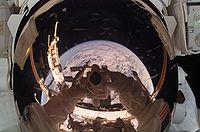
Thursday 16 August (Flight day 9)
The station and shuttle crews continued transfer activities on flight day 9, as well as EVA preparations, which included TPS repair procedure review, in case NASA decided a repair was necessary. [17] [18]
Mission Specialists Barbara Morgan and Alvin Drew participated in an education event in the morning with students at the Challenger Center for Space Science Education in Alexandria, Virginia. The event was hosted by Dr. June Scobee Rogers, wife of Challenger's commander, Dick Scobee, and Founding Chairman of the Challenger Center. Morgan and Drew also spoke to reporters from the Associated Press, Reuters and Idaho Public Television. [19]
During the interview with Reuters, Drew stated "We've been talking to the engineers who have been analyzing this far more than we have in space, and they seem to feel that the biggest danger is more to just being able to re-use Endeavour once it gets back on the ground. They seem to be confident, and I trust their confidence that we can get home safely even with the divot that we have in the belly," [20] Morgan added "We have a lot of faith in the program, and we'll do what the engineers decide is the best thing for us to do. We have all confidence we're going to be able to do the right thing."
At 01:00 UTC, Friday August 17, CAPCOM Shane Kimbrough notified commander Kelly that the Mission Management Team decided that no repair to the damaged tile on the underside of the orbiter would be required. [21] [22]
During the Mission Management Team briefing, John Shannon announced the team's unanimous decision that an EVA to repair the damaged tile was not required, and the tile damage on the underside of the orbiter was not a threat to crew safety. However, the spacewalk to repair the damage could pose a variety of risks, and those risks weighed heavily into the final decision. He noted the arc jet tests actually showed a higher degree of damage than the orbiter would sustain during re-entry, so the tests were helpful in showing the worst "possible" damage, and still did not damage the tile during testing enough to warrant repair. [23]
Shannon did note that the JSC Engineering Independent Group advised NASA managers that repairing the damage on-orbit could assist with mission turn-around time once the orbiter was on the ground. Shannon noted that the risks associated with in-flight repair outweighed the possible delay in processing the orbiter following the mission. He stated that normal turn-around time would not be compromised, as most orbiters have at least 60 tiles replaced after each mission, so the situation would not be any different than past missions. [24]
When pressed during the briefing by a reporter as to the chance of shuttle or crew loss, Shannon reported "I am 100 percent comfortable that the work that has been done, has accurately characterized the damage, and that we will have a very successful re-entry". He stated that over 200 people were involved in the decision, representing over 30 organizations, including NASA Ames Research Center, NASA's Langley Research Center, Jet Propulsion Laboratory, KSC, JSC, and that all the groups combined came to the same decision.
Shannon reported that the glove issue encountered during EVA three had been discussed, and stated that analysis would be continued, in advance of EVA four on Saturday. The crew does have a spare set of gloves, if needed.
Shannon reported on a micro-meteoroid debris strike discovered on the commander's window of the orbiter, which was 1 millimeter in depth. Shannon noted that it was consistent with previous damage sustained on past missions. Analysis would be conducted regarding this issue, using photographs sent down by the crew early Thursday morning.
The final item discussed was Hurricane Dean, which was heading towards the Caribbean Sea, and projected to move into the Gulf of Mexico. Contingency procedures and plans were in place, but Shannon did not anticipate it would affect the mission's timeline at all.
Friday 17 August (Flight day 10)
The station and shuttle crews had a relatively quiet day on Friday, continuing transfer operations, and doing some troubleshooting on a communication system between the shuttle and station. The two crews took some time out to have a joint news conference with US and Canadian news agencies, and took the official combined crew portrait.[25] When asked by reporters on the ground whether the crew agreed with NASA's decision to return without repairing the damage to Endeavour's underside, Commander Kelly replied, "We agree absolutely 100 percent with the decision to not repair the damage."[26]
During the mission status briefing, Lead Flight Director Matt Abbott discussed the ongoing preparations and plans with regards to Hurricane Dean, and reported NASA was watching the storm's track closely. If required, contingency plans are available. While the mission's timeline could be changed if required, no decision was made, and the mission was proceeding as planned. [27]
Deputy ISS Program Manager Kirk Shireman reported the S-Band system relocated during the third EVA was working well, and the SSPTS provided enough oxygen to be able to completely fill all reserves on the station. Shireman commented that transfer operations were approximately 75% complete.
EVA Office Manager Steve Doering reported on the decision to proceed with Saturday's EVA. The team analyzed the video downlinked from the third EVA, and the review showed no evidence of any specific event that would indicate a sharp edge, or excessive wear. A review of the manufacturing of the gloves was done, and no concerns were identified. The paths taken by astronauts during spacewalks were reviewed, identifying common paths between the third EVA, and Saturday's planned EVA, and the crew was notified of the common locations, to identify areas where additional glove inspections would be performed on Saturday. Overall, the final EVA would be less "hand-intensive" than the previous spacewalks, and the conclusion following the analysis was that Saturday's EVA would go ahead as planned. [28]
Saturday 18 August (Flight day 11)
NASA Managers decided overnight to shorten the fourth EVA by two hours as a precaution due to Hurricane Dean's continued path into the Gulf of Mexico. [29] The EVA duration was five hours and 2 minutes, with a total EVA time of 23 hours and 15 minutes for the mission. The EVA accomplished three primary objectives, and one get-ahead task. Two tasks were deferred: plans to tie down debris shields on the Destiny lab, and relocation of a tool box.[30] During the spacewalk, Williams and Anderson got a good look at Hurricane Dean, and were both awed at the sight. "Holy smoke" was Anderon's initial comment. "Man, that's impressive", Williams replied. Anderson added "They're only impressive when they're not coming towards you."[31] Transfer activities were completed ahead of schedule, and both crews worked hard to get everything transferred back to Endeavour after the spacewalk.
Dave Williams set two records during his third EVA; He is the Canadian with the most spacewalks (3); and he passed Canadian Astronaut Chris Hadfield in total EVA time. Williams ended Saturday's EVA with a total of 17 hours, 47 minutes of extravehicular time. [32]
During the mission status briefing, Launch Integration Manager LeRoy Cain[33] reported that the Mission Management Team decided to take extra precautions in preparation for the storm, and STS-118 would be cut short a day. In the event of a hurricane evacuation in Houston, an emergency command center would need to be set up. While it was a contingency set in place for years, NASA would prefer to avoid that situation. To that end, Cain reported the EVA was shortened, and the hatch closure would be done Saturday evening, rather than Sunday as planned. Undocking would be at 11:57 UTC Sunday, with the first KSC Landing opportunity on Tuesday, 21 August.
At 19:46, a short farewell ceremony was performed, followed by hatch closure at 20:10 UTC. Tuesday's tentative KSC landing time would be 12:32 p.m. EST. (16:30 UTC)[34]
Sunday 19 August (Flight day 12)
Endeavour successfully undocked from the International Space Station at 11:56 UTC. Saturday, NASA managers decided the station fly-around that is normally performed following each mission would not be conducted in order to give the Shuttle crew more free time during flight day 12. After several long work days, the Mission Control team felt the crew needed some downtime before the landing process began.
After undocking, two 4-second firings of the Reaction Control System were performed, in order to distance Endeavour from the station and move to a position above it. There, the crew deployed the robotic arm, beginning Late Inspection of the reinforced carbon-carbon tiles on the nose cap and wing leading edges.[35]
At the mission status briefing, Matt Abbott reported the undocking was "flawless", and the late inspection was completed successfully. Monday would be a standard pre-landing day, with checkout of the various systems on Endeavour, as well as an educational media event. Entry Flight Director Steve Stich and the entry team will take over mission duties tonight, in preparation for Tuesday's landing.
John Shannon reported the mission management team meeting went well. The landing plan was reviewed, and all teams reported "go" for landing on Tuesday. The latest track for Hurricane Dean was favorable for the Houston area; the storm seemed to be swinging farther south than originally expected. NASA managers were optimistic that contingency plans would not be needed. Final decisions regarding alternate plans would not be made until Monday, but Shannon noted that White Sands Space Harbor landing facility would be removed as an alternate site. Edwards Air Force Base, and Kennedy Shuttle Landing Facility would be the two sites evaluated on Monday.
Monday 20 August (Flight day 13)
On Monday, with the shuttle approximately 68 miles behind the International Space Station, the crew of Endeavour performed a variety of check-out tests in preparation for entry, configured the Spacehab module for entry, and did some last minute stowage. Kelly and Hobaugh worked with the shuttle landing simulator on board, practicing the anticipated landing tracks. Kelly, Williams and Morgan took some time out to talk to students at the Canadian school, La Ronge, in Saskatchewan.
During the mission status briefing, Entry Flight Director Steve Stich reported the track of Hurricane Dean would not require the activation of contingency plans, and the forecast looked favorable for a Tuesday landing at Kennedy Shuttle Landing Facility.[36] There were also two opportunities for a Florida landing, with the first opportunity beginning with a deorbit burn at 15:25 UTC, and landing at 16:32 UTC. The second opportunity would call for a deorbit burn at 17:00 UTC, with landing at 18:16 UTC. Weather was not expected to interfere with landing, with a forecast of high clouds, but no inclement weather. If the second landing opportunity was taken, the shuttle would fly directly over Hurricane Dean, although it would be well above any effects of the storm. NASA did plan to call up Edwards Air Force Base as the backup site, which had two opportunities on Tuesday, but the plan was to attempt a KSC landing, and if both opportunities were waved off, NASA would decide whether to wait a day, and try for a Wednesday landing at KSC. If Wednesday opportunities at Florida were waved off due to weather, a landing at Edwards Air Force Base would be attempted. [37]
Tuesday 21 August (Flight day 14, Landing)
The crew of Endeavour went right to work after waking up on Tuesday, completing the close-out of the Spacehab module, and getting into the deorbit preparations timeline.[38] They closed payload bay doors, transitioned the vehicle computers to landing software mode and donned their reentry suits. At 14:30 UTC, the crew was given the "go" to begin fluid loading. This was done to assist with the crew's ability to adjust to gravity, and to prevent hypotension after landing. At 12:30 UTC, the Space Flight Meteorology Group reported to Entry Team Flight Director Steve Stich that the weather forecast was a "go". The weather at Kennedy Space Center showed only scattered showers moving away from the landing facility, and cross winds were not expected to be a problem. At 15:08 UTC, the crew was given a "go" for the deorbit burn, and the auxiliary power units were started at 15:20 UTC. The 4 minute engine burn was successfully completed at 15:28 UTC, slowing Endeavour by approximately 252 miles per hour, (405 km/h) and adjusting the orbiter's trajectory correctly for landing.
Radar acquisition of Endeavour through MILA happened at 16:19 UTC. At 16:20 UTC, the shuttle had passed the area of peak heating, with no issues reported on board. Main landing gear touchdown occurred at 16:32:16 UTC with nose gear touchdown at 16:32:29 UTC. The orbiter came to a complete stop at 16:33:20 UTC.[39] Upon wheel stop, CAPCOM Christopher Ferguson told the crew, "Congratulations, you've given a new meaning to the term 'higher education.'"[40]
Initial post-landing inspection of the orbiter showed very little additional damage to the thermal tiles affected by the foam strike during launch. Barbara Morgan did not exit the crew transport vehicle with the rest of the crew; she remained on board the vehicle to receive additional medical tests, and would return to the Astronaut Crew Quarters in that vehicle.[41] The remaining six crew members briefly examined the orbiter, doing the traditional post-flight "walkaround", posed for photos, and then returned to the crew quarters in the AstroVan.
During the post-landing briefing, NASA Administrator Michael D. Griffin reported that the International Space Station was approximately 60% completed following STS-118. Griffin also stressed the importance of space exploration, and added that the damaged tile on the underside of the orbiter did very well during re-entry.
International Space Station Program Manager William H. Gerstenmaier reported the damage was actually less than what the arc jet testing produced, a situation that NASA anticipated, and managers had earlier stressed that arc jets show "worst possible" damage. Launch and Entry Flight Director Mike Leinbach stressed how pleased he was with the mission, and with the condition of the vehicle following re-entry. He stated it was "one of the cleanest vehicles the managers have seen since the Return to Flight policies were implemented, if not the cleanest."
At the end of the briefing, Griffin commented to the media who focused on Barbara Morgan being the first "teacher in space", that Morgan was not technically a "teacher in space", nor was she an "Educator Astronaut". He stated she was accepted as a Mission Specialist, before the new class of Mission Specialist Educators were selected in 2004, and NASA considers her to be a mission specialist, who was once a teacher. [42] However, NASA does refer to Morgan as a Mission Specialist Educator in a number of interviews, so the terms seem to be interchangeable to most, if not to Griffin.
During the post-landing crew press conference, Kelly was asked "Did the tile damage enter your mind at all during re-entry, and what did you think about it once you got a look during the walkaround?" Kelly's reply was, "I thought about it, but only because I knew I'd be asked about it. I didn't worry about it at all. I was underwhelmed by it."[43]
| “ | You know, there's a great sense of pride to be able to be involved in a human Endeavour that takes us all a little bit farther, when you look down and see our Earth... and you realize what we are trying to do as a human race, it's pretty profound. - Barbara Morgan [44] | ” |
References
- ↑ NASA. STS-118 Status Report 03, NASA, 2007-08-09. Retrieved on 2007-08-13.
- ↑ NASA. Space Shuttle Reference Manual - Thermal Protection System, NASA, 2000-08-31. Retrieved on 2007-08-13.
- ↑ Harwood, William. Mission status briefing; tank appears to have performed well, CBS News, 2007-08-11. Retrieved on 2007-08-11.
- ↑ NASA. STS-118 Flight Day 3 Status Report. NASA.
- ↑ NASA. STS-118 Flight day 5 Status Report, NASA. Retrieved on 2007-08-13.
- ↑ Shannon, John. Image of area of interest on Endeavour, NASA. Retrieved on 2007-08-12.
- ↑ Shannon, John. Mission Status Briefing Graphics, NASA. Retrieved on 2007-08-14.
- ↑ Harwood, William. New gyro installed; spacewalk ends, CBS Space News, 2007-08-14. Retrieved on 2007-08-14.
- ↑ Harwood, William. Update: Shannon said tile damage not considered a threat to astronauts, CBS Space News, 2007-08-14. Retrieved on 2007-08-14.
- ↑ NASA. STS-118 Status Report #13, NASA, 2007-08-14. Retrieved on 2007-08-15.
- ↑ Harwood, William. Kelly downplays tile concern; Morgan said spaceflight worth the wait, CBS News, 2007-08-14. Retrieved on 2007-08-14.
- ↑ Boehm, Paul. STS-118 Mission Status Briefing Graphics, NASA, 2007-08-15. Retrieved on 2007-08-16.
- ↑ Harwood, William. Mastracchio cuts spacewalk short after noting glove damage, CBS, 2007-08-15. Retrieved on 2007-08-15.
- ↑ Montalbano, Joel. Mission Status Briefing Graphics, NASA, 2007-08-16. Retrieved on 2007-08-16.
- ↑ NASA. Status Report #15, NASA, 2007-08-16. Retrieved on 2007-08-16.
- ↑ Harwood, William. Spacewalk No. 4 moved from Friday to Saturday; no decision yet on tile repair, CBS, 2007-08-15. Retrieved on 2007-08-15.
- ↑ Dunn, Marcia. Astronauts run through repair methods, Associated Press, 2007-08-17. Retrieved on 2007-08-17.
- ↑ Malakoff, David. NASA Nears Decision on Shuttle Repair, NPR, 2007-08-17. Retrieved on 2007-08-17.
- ↑ Austin Peterson, Liz. NASA Optimistic No Shuttle Fix Needed, AP/Discovery News, 2007-08-17. Retrieved on 2007-08-17.
- ↑ Klotz, Irene. Shuttle crew awaits word on heat shield work, Reuters, 2007-08-17. Retrieved on 2007-08-17.
- ↑ NASA. STS-118 Mission Status Report #17, NASA, 2007-08-17. Retrieved on 2007-08-17.
- ↑ Chang, Kenneth. NASA Rules Out Repair to Gouge in Shuttle, New York Times, 2007-08-17. Retrieved on 2007-08-17.
- ↑ Shannon, John. STS-118 Mission Status Briefing Graphics, NASA, 2007-08-17. Retrieved on 2007-08-17.
- ↑ Dunn, Marcia. NASA Decides No Shuttle Repairs Needed, AP/Washington Post, 2007-08-17. Retrieved on 2007-08-17.
- ↑ NASA. STS-118 Status Report #18, NASA, 2007-08-17. Retrieved on 2007-08-17.
- ↑ AP. Astronauts '100 percent' behind skipping repairs, CNN, 2007-08-17. Retrieved on 2007-08-17.
- ↑ Klotz, Irene. Hurricane threat may bring shuttle home early, Reuters, 2007-08-17. Retrieved on 2007-08-17.
- ↑ NASA. STS-118 Status Report #19, NASA, 2007-08-18. Retrieved on 2007-08-18.
- ↑ NASA. STS-118 Mission Status Briefing Graphics, NASA, 2007-08-18. Retrieved on 2007-08-18.
- ↑ NASA. STS-118 Status Report #21, NASA, 2007-08-19. Retrieved on 2007-08-19.
- ↑ Harwood, William. Astronauts marvel at Hurricane Dean, CBS News. Retrieved on 2007-08-19.
- ↑ Blatchford, Andy. Astronaut Dave Williams sets Canadian record with third spacewalk, CanadaEast Telegraph-Journal, 2007-08-19. Retrieved on 2007-08-19.
- ↑ NASA. LeRoy E. Cain Biography, NASA, 2007-05. Retrieved on 2007-08-18.
- ↑ Dunn, Marcia. NASA orders shuttle home 1 day early because of hurricane, AP/Houston Chronicle, 2007-08-18. Retrieved on 2007-08-18.
- ↑ Associated Press. Shuttle heads home, aiming to beat storm, AP / MSNBC, 2007-08-19. Retrieved on 2007-08-19.
- ↑ Austin Peterson, Liz (2007-08-20). Astronauts Prepare for Tuesday Return. San Francisco Chronicle/AP. Retrieved on 2007-08-20.
- ↑ NASA (2007-08-20). STS-118 Landing Ground Tracks. NASA. Retrieved on 2007-08-20.
- ↑ NASA. STS-118 Status Report #26, NASA, 2007-08-21. Retrieved on 2007-08-21.
- ↑ NASA. NASA STS-118 Landing Blog, NASA, 2007-08-21. Retrieved on 2007-08-21.
- ↑ Klotz, Irene. Space shuttle Endeavour lands safely in Florida, Reuters, 2007-08-21. Retrieved on 2007-08-21.
- ↑ Harwood, William. Shuttle Endeavour glides to smooth Florida landing, SR-77, CBS News, 2007-08-21. Retrieved on 2007-08-21.
- ↑ Michael Griffin, NASA TV STS-118 Post-Landing briefing
- ↑ Chang, Kenneth. Shuttle Glides Safely Home in Spite of Damage, New York Times, 2007-08-21. Retrieved on 2007-08-22.
- ↑ Malik, Tariq. Teacher-Astronaut, Crewmates Glad to be Home, Space.com, 2007-08-22. Retrieved on 2007-08-22.

